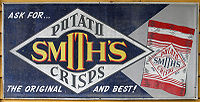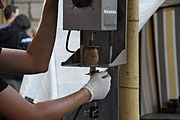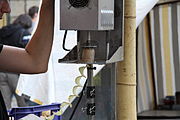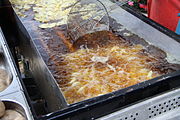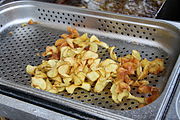- Potato chip
-
Potato chips 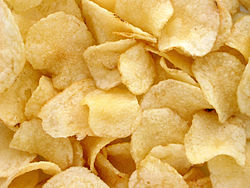
Potato chipsOrigin Place of origin Saratoga Springs, New York, United States Dish details Course served Snack, side dish Serving temperature Room temperature Potato chips (known as crisps in British and Hiberno English; either chips or wafers in Indian English; and chips in American, Australian, New Zealand, Canadian, Singapore, South African, and Jamaican English) are thin slices of potato that are deep fried. Potato chips are commonly served as an appetizer, side dish, or snack. The basic chips are cooked and salted; additional varieties are manufactured using various flavorings and ingredients including seasonings, herbs, spices, cheeses, and artificial additives.
Crisps, however, refer to many different types of snack products in the UK and Ireland, some made from potato, but may also be made from maize and tapioca. An example of these kinds of crisps is Monster Munch.[1] Crisps is also used in North America to refer to potato snacks made from reconstituted dried potato flakes and other fillers,[citation needed] such as "baked Lay's" and Pringles, although Pringles are technically "quick-fried" in oil.
Potato chips are a predominant part of the snack food market in English-speaking countries and numerous other Western nations. The global potato chip market generated total revenues of US$16.4 billion in 2005. This accounted for 35.5% of the total savory snacks market in that year (US$46.1 billion).[2]
Contents
History
According to a traditional story, the original potato chip recipe was created in Saratoga Springs, New York on August 24, 1853. Agitated by a patron repeatedly sending his fried potatoes back because they were too thick, soggy and bland, resort hotel chef, George Crum, decided to slice the potatoes as thin as possible, frying them until crisp and seasoning them with extra salt. Contrary to Crum's expectation, the patron (sometimes identified as Cornelius Vanderbilt) loved the new chips[3] and they soon became a regular item on the lodge's menu under the name "Saratoga Chips".[4]
In the 20th century, potato chips spread beyond chef-cooked restaurant fare and began to be mass produced for home consumption. The Dayton, Ohio-based Mike-sell's Potato Chip Company, founded in 1910, calls itself the "oldest potato chip company in the United States".[5] New England-based Tri-Sum Potato Chips, originally founded in 1908 as the Leominster Potato Chip Company, in Leominster, Massachusetts claim to be America's first potato chip manufacturer.[6] Chips sold in markets were usually sold in tins or scooped out of storefront glass bins and delivered by horse and wagon. The early potato chip bag was wax paper with the ends ironed or stapled together. At first, potato chips were packaged in barrels or tins, which left chips at the bottom stale and crumbled. Laura Scudder,[7] an entrepreneur in Monterey Park, California started having her workers take home sheets of wax paper to iron into the form of bags, which were filled with chips at her factory the next day. This pioneering method reduced crumbling and kept the chips fresh and crisp longer. This innovation, along with the invention of cellophane, allowed potato chips to become a mass market product. Today, chips are packaged in plastic bags, with nitrogen gas blown in prior to sealing to lengthen shelf life, and provide protection against crushing.[8]
Flavored chips
In an idea originated by the Smiths Potato Crisps Company Ltd, formed in 1920,[9] Frank Smith originally packaged a twist of salt with his crisps in greaseproof paper bags, which were then sold around London.
The potato chip remained otherwise unseasoned until an innovation by Joe "Spud" Murphy (1923–2001),[10] the owner of an Irish crisp company called Tayto, who developed a technology to add seasoning during manufacture in the 1950s. After some trial and error, Murphy and his employee, Seamus Burke,[11] produced the world's first seasoned crisps, Cheese & Onion and Salt & Vinegar.
The innovation became an overnight sensation in the food industry with the heads of some of the biggest potato chip companies in the United States traveling to the small Tayto company in Ireland to examine the product and to negotiate the rights to use the new technology. Companies worldwide sought to buy the rights to Tayto's technique. The sale of the Tayto company made the owner and the small family group, who had changed the face of potato chip manufacturing, very wealthy.
The Tayto's innovation changed the entire nature of the potato chip, and led to the end of Smith's twist of salt. (Walkers revived the idea of "salt in a bag", following their takeover of Smith's (UK) in 1979, with their Salt 'n' Shake potato crisps.[12]) Later chip manufacturers added natural and artificial seasonings to potato chips with varying degrees of success. A product that had had a large appeal to a limited market on the basis of one seasoning now had a degree of market penetration through vast numbers of seasonings. Various other seasonings of chips are sold in different locales, including the original Cheese and Onion, produced by Tayto, which remains by far Ireland's biggest manufacturer of crisps.
Nomenclature
There is little consistency in the English speaking world for names of fried potato cuttings. American and Canadian English use "chips" for the above mentioned dish—this term is also used (but not universally) in other parts of the world, due to the influence of American culture—and sometimes "crisps" for the same made from batter.
In the United Kingdom and Ireland crisps are potato chips while chips refer to thick strips similar to french fries (as in "fish and chips") and served hot. In Australia, some parts of South Africa, the south of New Zealand, India, the general West Indies especially in Barbados, both forms of potato product are simply known as "chips", as are the larger "home-style" potato crisps. In the north of New Zealand they are known as "chippies" but are marketed as "chips" throughout the country. Sometimes the distinction is made between "hot chips" (fried potatoes) and "potato chips" in Australia and New Zealand. In Bangladesh, they are generally known as chip or chips, and much less as crisps (pronounced "kirisp") and locally Álu Bhaja.
Health concerns
Potato chips were originally fried and seasoned without concern for trans fats, sodium, sugar, or other nutrient levels. As nutritional intake guidelines were created in various countries and the nutrition facts label became commonplace, consumers, advocacy groups, and health organizations have focused on the nutritional value of so-called junk foods, including potato chips.[13]
A recent long term study associates potato chips consumption as most important contributor to weight change, before potatoes and soft drinks.[14]
Some potato chip companies have responded to the criticism, both informal and legal, by investing in research and development to modify existing recipes and create health-conscious products. Kettle Foods was founded in 1978 and currently sells only trans fat-free products, including potato chips. PepsiCo research shows that approximately 80% of salt on chips is not sensed by the tongue before being swallowed. Frito-Lay spent $414 million in 2009 on product development, including development of salt crystals that would reduce the salt content of Lay's potato chips without adversely affecting flavor.[13]
Examples of regional varieties
- In Australia, popular flavors include plain (salted), roast chicken, barbecue, and salt & vinegar. In recent years, other flavors have become popular, including lime and pepper, chili, sour cream & chives, sweet chilli sauce & sour cream, honey soy chicken and Caesar salad. Until recently, a doner kebab flavor was manufactured by Arnott's.[citation needed]
- In Austria, garlic flavored potato chips are available.
- In Bulgaria, plain salted, paprika, sour cream and onion, and cheese and hot chili are popular flavors. Barbecue and ketchup flavored chips are also available.
- In Canada, seasonings include dill pickle, ketchup, barbecue, Buffalo wings and blue cheese, onion and garlic, jalapeño and cheddar, all dressed, salt and vinegar, salt and pepper, sour cream and bacon, sour cream and cheddar, sour cream and onion, roast chicken, fries and gravy, and curry. In Toronto and Vancouver, Lay's offers wasabi chips.[15]
- In mainland China, Lay's has introduced potato chips flavored in Chinese cuisine, world cuisine, and flavors such as cucumber.
- In Colombia, the five main flavors of chips are natural (ready salted), barbecue, chicken, mayonnaise and Limón.
- In Egypt, Chipsy is the most popular brand of potato chips. It has some flavors inspired by the local cuisine, such as Kebab, Stuffed vine leaves, etc.
- In Finland, the market leader in potato chips business is Åland based Taffel (known in Denmark and Norway as KiMs and marketed in Sweden under the name OLW) with popular cheese flavored "Juusto Snacks", salt flavored "Chips", sour cream and onion flavored "Broadway", and barbecue flavored "Grill Chips", in general sour cream & onion- and barbecue -flavored potato chips are among the most popular flavors regardless of the manufacturer, popular brands include, in addition to domestic Taffel, few foreign brands such as Estrella and Pringles.
- In Germany, the most common flavor is paprika. More exotic varieties are also beginning to appear, including salt & vinegar and Asian flavors. The most recent development is the Salt & Pepper-flavor and product lines from organic farming. The legendary beer flavored chips seem to be more of a myth, the most recent general availability of beer flavored chips was a soccer world cup 2006 special edition by Lorenz Snack-World. The dominating brands are Chio Chips and funny frisch, both manufactured by Intersnack, Crunchips, manufactured by Lorenz Snack-World, and Pringles. Other foreign brands like Lay's or Kettle are available sporadically, but do not usually play a major role.
- In Greece, oregano flavored chips are very popular.
- In Hong Kong, the two prominent potato chips are the spicy "Ethnican" variety by Calbee,[16] and barbecue by Jack'n Jill. Lay's are also popular in Hong Kong. (With the most popular being BBQ and sour cream and onion.)
- In India and Pakistan, there are a number of flavored varieties both in locally made and multi-national brands, such as Lay's. Some flavors are tomato, pudina (mint), masala, coriander, salt and pepper, and red chili powder. The most popular chip varieties are potato, tapioca, and plantain (yellow or green, each with its own distinct taste).
- In Indonesia, barbecue, corn, and roast chicken are the favorites. Another variety of chips are cassava chips.
- In Ireland, the common varieties of crisps are similar to those sold in the UK. However in Ireland, the word Tayto is synonymous with crisps after the Tayto brand and can be used to describe all varieties of crisp, including those not produced by Tayto. Owing to the dominance of Tayto in the Irish market, the word has become a genericized trademark. Walkers crisps were launched there several years ago, but have failed to dominate the market. Hunky Dorys and King crisps are other popular Irish brands. In Irish, crisps are known as criospaí.
- In Japan, flavors include nori & salt, consommé, wasabi, soy sauce & butter, garlic, ume, barbecue, pizza, mayonnaise, and black pepper. Chili, scallop with butter, teriyaki, takoyaki and yakitori flavored chips are also available. Major manufacturers are Calbee,[17] Koikeya[18] and Yamayoshi.
- In Mexico, many flavors are spicy. Popular flavors are salt, lime, habanero, 'Chile y Limón' and cheese.
- In some Middle Eastern countries,[clarification needed] many popular American flavors and chicken-flavored chips are available. In others, salt and salt and pepper varieties are the most popular.
- In the Netherlands, the market is dominated by Lay's; they offer many flavors, such as: natural (salted), paprika, bolognese (Italian herbs and tomato), barbecued ham, cheese & onion, Mexican herbs, Heinz tomato ketchup, chili, spareribs, Mediterranean herbs, Thai sweet chili, Oriental spices, pepper & cream, chicken & thyme, and spices & lime. Natural (salted) and paprika crisps are the most popular.
- In New Zealand, the most popular varieties of potato chips are ready salted, salt n' vinegar and chicken. In 2009, Bluebird Foods Limited released a unique range of chips made of classic New Zealand flavors such as 'Meat Pie and Ketchup' and 'Reduced Cream and Onion Soup Dip 'Sunday Roast'. The range is named 'Kiwi As'.
- In Norway, most chips are flavored with salt, salt and pepper or paprika. More exotic flavors like mushroom and horseradish are also available. Major brands include KiMs, Maarud and Sørlandschips.
- In Philippines, favorites include cheese, barbecue, and sour cream and onion.
- In Russia, popular flavors are plain (salted), onion, paprika, black pepper, and sour cream, more unusual varieties are bacon, shashlik, crab, and caviar. Both Lay's and Pringles brands are widespread. Russian companies like Perekrestok also manufacture their own chips.
- In Singapore, popular brands are barbecue flavored Jack and Jill Potato Chips, Sour Cream and Onion Lays, Chipster and the brand Lay's Kettle Cooked Chips.
- In Serbia, popular potato chips are plain (salted), pizza, grill and ketchup flavored. The Chipsy company holds most of the Serbian potato chip market.
- South Africa has many potato chip flavors, including "fruit chutney", "biltong" (beef jerky), "sausage", "Worcestershire sauce", "peri peri" (Mozambican/Portuguese hot sauce flavor) and tomato sauce (ketchup flavor) among many others.
- In Spain, the most popular flavors are plain (fried with olive oil and salted), and ham.
- In Sweden, the two dominant companies are Estrella (owned by Kraft Foods) and OLW. The most popular flavors are salted, grill (onion flavored), sour cream & onion, and dill. Exotic flavors include sour cream & bearnaise and hot sweet chili. Chips made of unpeeled potatoes, called lantchips, are also common. Another common chips-brand is Pringles.
- The market in the United Kingdom is dominated by Walkers (a regional brand of Lay's) which is known for its wide variety of crisps. The three main flavors are ready salted, cheese & onion, and salt & vinegar; however, other examples are prawn cocktail, Worcestershire sauce (known by Walkers as Worcester Sauce), roast chicken, steak & onion, smoky bacon, lamb & mint, ham & mustard, barbecue, BBQ rib, tomato ketchup, sausage & ketchup, pickled onion, Branston Pickle, and Marmite. More exotic flavors are Thai sweet chili, roast pork & creamy mustard sauce, lime and Thai spices, chicken with Italian herbs, sea salt and cracked black pepper, turkey & bacon, caramelized onion & sweet balsamic vinegar, stilton & cranberry, mango chili, and special flavors such as American Cheeseburger and English Roast Beef & Yorkshire Pud.[19] Kettle Foods Ltd's range of thick-cut crunchy crisps include gourmet flavors: Mexican Limes with a hint of Chilli, Salsa with Mesquite, Buffalo Mozzarella Tomato and Basil, Mature Cheddar with Adnams Broadside Beer, Soulmate Cheeses and Onion, and other previously listed flavors. Most seasonings contain only vegetarian ingredients, although some recent seasonings such as lamb & mint sauce contain meat extracts. In the early 1980s, Hedgehog brand flavored crisps were widely on sale and received much publicity. McCoys Crisps are also popular in the UK. In Northern Ireland Tayto (NI) Ltd. dominate the market.[citation needed] This company is entirely unrelated to the Tayto company in Ireland. In the north of England, Seabrook Potato Crisps are popular, but they are much less common in the south.
- In the United States, popular potato chips flavors include original (plain or with salt), sour cream and onion, barbecue, ranch dressing, salt and vinegar, and cheddar and sour cream. Stores in regions with a significant Hispanic population sell lime flavored chips using the Mexican name, limón.[20]
Similar foods
Another type of potato chip, notably the Pringles and Lay's Stax brands, is made by extruding or pressing a dough made from ground potatoes into the desired shape before frying. This makes chips that are very uniform in size and shape, which allows them to be stacked and packaged in rigid tubes. In America, the official term for Pringles is "potato crisps", but they are rarely referred to as such. Conversely Pringles may be termed "potato chips" in Britain, to distinguish them from traditional "crisps".
An additional variant of potato chips exists in the form of "potato sticks", also called "shoestring potatoes". These are made as extremely thin (2–3 mm) versions of the popular French fry, but are fried in the manner of regular salted potato chips. A hickory-smoke flavor version is popular in Canada, going by the vending machine name "Hickory Sticks". Potato sticks are typically packaged in rigid containers, although some manufacturers use flexible pouches, similar to potato chip bags. Potato sticks were originally packed in hermetically sealed steel cans. In the 1960s, manufacturers switched to the less expensive composite canister (similar to the Pringle's container). Reckitt Benckiser was a market leader in this category under the Durkee Potato Stix and French's Potato Sticks names, but exited the business in 2008.
A larger variant (approximately 1 cm thick) made with dehydrated potatoes is marketed as Andy Capp's Pub Fries, using the theme of a long-running British comic strip, which are baked and come in a variety of flavors. Walkers make a similar product called "Chipsticks" which are Salt and Vinegar flavored. The Ready Salted flavor had been discontinued.
Some companies have also marketed baked potato chips as an alternative with lower fat content. Additionally, some varieties of fat-free chips have been made using artificial, and indigestible, fat substitutes. These became well known in the media when an ingredient many contained, Olestra, was linked in some individuals to abdominal discomfort and loose stools.[21]
The success of crisp fried potato chips also gave birth to fried corn chips, with such brands as Fritos, CC's and Doritos dominating the market. "Swamp chips" are similarly made from a variety of root vegetables, such as parsnips, rutabagas and carrots. Japanese-style variants include extruded chips, like products made from rice or cassava. In South Indian snack cuisine, there is an item called HappLa in Kannada/vadam in Tamil, which is a chip made of an extruded rice/sago or multigrain base that has been around for many centuries.
There are many other products which might be called "crisps" in Britain, but would not be classed as "potato chips" because they aren't made with potato and/or aren't chipped (for example, Wotsits, Quavers, Skips, Hula Hoops and Monster Munch).
Kettle-style chips (known as hand-cooked in the UK/Europe) are traditionally made by the "batch-style" process, where all chips are fried all at once at a low temperature profile, and continuously raked to prevent them from sticking together. There has been some development recently where kettle-style chips are able to be produced by a "continuous-style" process (like a long conveyor belt), creating the same old-fashioned texture and flavor of a real kettle-cooked chip.
Non-potato based chips also exist. Kumara (sweet potato) chips are eaten in Korea, New Zealand and Japan; parsnip, beetroot and carrot crisps are available in the United Kingdom. India is famous for a large number of localized 'chips shops', selling not only potato chips but also other varieties such as plantain chips, tapioca chips, yam chips and even carrot chips. Plantain chips, also known as chifles or tostones, are also sold in the Western Hemisphere from the United States to Chile. In the Philippines, banana chips can be found sold at local stores. In Kenya, chips are made even from arrowroot and casava. In the United Kingdom, Sweden, Finland and Australia, a new variety of Pringles made from rice have been released and marketed as lower in fat than their potato counterparts. Recently, the Australian company Absolute Organic has also released chips made from beetroot.
Gallery of production
- The process of making homemade chips
Notes
- ^ "Walkers Crisps". Pepsico. http://www.pepsico.co.uk/walkers-crisps. Retrieved 2010-08-09.
- ^ "PotatoPro/Datamonitor". Potatopro.com. http://www.potatopro.com/Pr/E-shot/Savory%20Snacks%20Global%20Industry%20Guide.aspx. Retrieved 2009-05-26.
- ^ "How potato chip is made - used, processing, product, machine, Raw Materials, The Manufacturing Process, Quality Control, Byproducts/Waste, The Future". Madehow.com. 1915-01-06. http://www.madehow.com/Volume-3/Potato-Chip.html. Retrieved 2010-08-03.
- ^ Civil War Recipes and Food History - The Potato During the Civil War
- ^ "Mike Sells Chipper Shipper Online Store". Mike-sells.com. http://www.mike-sells.com/about/. Retrieved 2009-05-26.
- ^ "Potato Chips". Atlas of Popular Culture in the Northeastern US. http://www.geography.ccsu.edu/harmonj/atlas/potchips.htm. Retrieved 2010-03-30.
- ^ http://www.laurascudders.com/History
- ^ "The History and Origin of Potato Chips". Students.cup.edu. http://students.cup.edu/mof8893/food/history.html. Retrieved 2010-08-03.
- ^ "BBC h2g2 Potato Crisps - A History". BBC. http://www.bbc.co.uk/dna/h2g2/A16455053. Retrieved 2009-05-26.
- ^ "Joe 'Spud' Murphy". Daily Telegraph. 2001-11-22. http://www.telegraph.co.uk/news/main.jhtml?xml=/news/2001/11/05/db02.xml. Retrieved 2007-08-23.
- ^ "Joe 'Spud' Murphy". Telegraph. 2001-11-05. http://www.telegraph.co.uk/news/obituaries/1361491/Joe-Spud-Murphy.html. Retrieved 2010-08-03.
- ^ "BBC h2g2 - Smiths Salt 'n' Shake Crisps". BBC. http://www.bbc.co.uk/dna/h2g2/A471377. Retrieved 2009-05-26.
- ^ a b McKay, Betsy (2010-03-22). "PepsiCo Develops 'Designer Salt' to Chip Away at Sodium Intake". Wall Street Journal. http://online.wsj.com/article/SB10001424052748704534904575131602283791566.html. Retrieved 2010-03-22.
- ^ Dariush Mozaffarian, M.D., Dr.P.H. et al. (2011-06-23). "Changes in Diet and Lifestyle and Long-Term Weight Gain in Women and Men". New England Magazine. http://www.nejm.org/doi/full/10.1056/NEJMoa1014296. Retrieved 2011-07-15.
- ^ "Lay's website". http://www.lays.ca/. Retrieved 2008-08-24.
- ^ "Calbee Four Seas Co. Ltd.". http://www.calbee.com.hk/html/tch/home/index.jsp. Retrieved 2008-08-24.
- ^ "Calbee カルビー株式会社". Calbee.co.jp. http://www.calbee.co.jp/index.php. Retrieved 2009-05-26.
- ^ "株式会社湖池屋|総合スナックメーカーのコイケヤ". Koikeya.co.jp. http://koikeya.co.jp/. Retrieved 2009-05-26.
- ^ "Walkers Flavour Cup". http://www.walkers.co.uk/flavourcup/faqs.html#/help/faqs. Retrieved 2010-10-15.
- ^ "LAY'S". Frito-Lay. http://www.fritolay.com/our-snacks/lays.html. Retrieved 2010-08-03.
- ^ "NIDDK...WIN Notes". Win.niddk.nih.gov. 1998-02-21. http://win.niddk.nih.gov/notes/summer98/artcl9.html. Retrieved 2009-05-26.
References
- Banham, Rayner (1977) "The Crisp at the Crossroads", in P. Barker (ed) Arts in Society. London: Fontana.
- Jones, Charlotte Foltz (1991). Mistakes That Worked. Doubleday. ISBN 0-385-26246-9. – Origins of potato chips
External links
 Media related to Potato chips at Wikimedia Commons
Media related to Potato chips at Wikimedia CommonsDeep-fried foods Banana chips · Chifle · Chicken fried bacon · Coca Cola · Egg roll · Fish · Finger steaks · French fries · Fried chicken · Fried pickle · Mars bar · Mozzarella sticks · Onion ring · Peanuts · Pizza · Potato chips · Tater tot · Tempura · Tortilla chip · Twinkie
Categories:- 1853 introductions
- American cuisine
- Deep fried foods
- Potato dishes
- Snack foods
Wikimedia Foundation. 2010.


